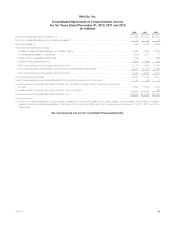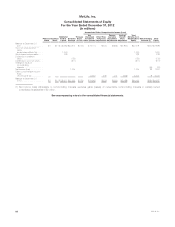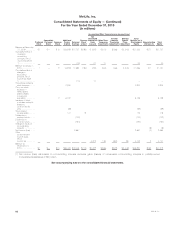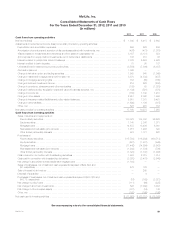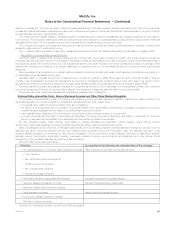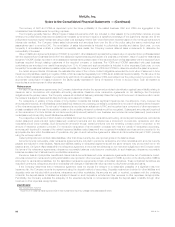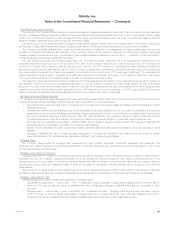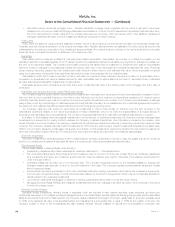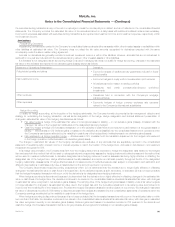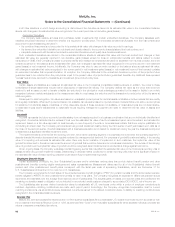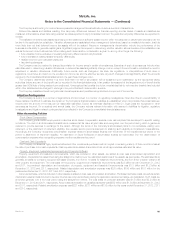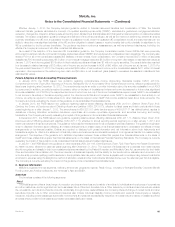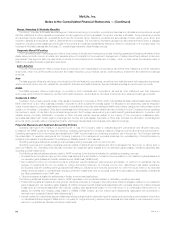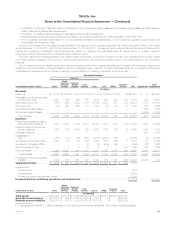MetLife 2012 Annual Report Download - page 95
Download and view the complete annual report
Please find page 95 of the 2012 MetLife annual report below. You can navigate through the pages in the report by either clicking on the pages listed below, or by using the keyword search tool below to find specific information within the annual report.
MetLife, Inc.
Notes to the Consolidated Financial Statements — (Continued)
Fixed Maturity and Equity Securities
The majority of the Company’s fixed maturity and equity securities are classified as available-for-sale (“AFS”) and are reported at their estimated
fair value. Unrealized investment gains and losses on these securities are recorded as a separate component of other comprehensive income (loss)
(“OCI”), net of policyholder-related amounts and deferred income taxes. All security transactions are recorded on a trade date basis. Investment
gains and losses on sales are determined on a specific identification basis.
Interest income on fixed maturity securities is recognized when earned using an effective yield method giving effect to amortization of premiums
and accretion of discounts. Prepayment fees are recognized when earned. Dividends on equity securities are recognized when declared.
The Company periodically evaluates fixed maturity and equity securities for impairment. The assessment of whether impairments have occurred
is based on management’s case-by-case evaluation of the underlying reasons for the decline in estimated fair value and an analysis of the gross
unrealized losses by severity and/or age. The analysis of gross unrealized losses is described further in Note 8 “— Evaluation of AFS Securities for
OTTI and Evaluating Temporarily Impaired AFS Securities.”
For fixed maturity securities in an unrealized loss position, an other-than-temporary impairment (“OTTI”) is recognized in earnings when it is
anticipated that the amortized cost will not be recovered. When either: (i) the Company has the intent to sell the security; or (ii) it is more likely than
not that the Company will be required to sell the security before recovery, the OTTI recognized in earnings is the entire difference between the
security’s amortized cost and estimated fair value. If neither of these conditions exist, the difference between the amortized cost of the security and
the present value of projected future cash flows expected to be collected is recognized as an OTTI in earnings (“credit loss”). If the estimated fair
value is less than the present value of projected future cash flows expected to be collected, this portion of OTTI related to other-than-credit factors
(“noncredit loss”) is recorded in OCI. Adjustments are not made for subsequent recoveries in value.
With respect to equity securities, the Company considers in its OTTI analysis its intent and ability to hold a particular equity security for a period of
time sufficient to allow for the recovery of its estimated fair value to an amount equal to or greater than cost. If a sale decision is made for an equity
security and recovery to an amount at least equal to cost prior to the sale is not expected, the security will be deemed to be other-than-temporarily
impaired in the period that the sale decision was made and an OTTI loss will be recorded in earnings. The OTTI loss recognized is the entire
difference between the security’s cost and its estimated fair value with a corresponding charge to earnings.
Fair Value Option and Trading Securities
FVO and trading securities are stated at estimated fair value and include investments for which the FVO has been elected (“FVO Securities”) and
investments that are actively purchased and sold (“Actively Traded Securities”). FVO Securities include:
‰fixed maturity and equity securities held-for-investment by the general account to support asset and liability matching strategies for certain
insurance products;
‰contractholder-directed investments supporting unit-linked variable annuity type liabilities which do not qualify for presentation and reporting
as separate account summary total assets and liabilities. These investments are primarily mutual funds and, to a lesser extent, fixed maturity
and equity securities, short-term investments and cash and cash equivalents. The investment returns on these investments inure to
contractholders and are offset by a corresponding change in PABs through interest credited to policyholder account balances; and
‰securities held by consolidated securitization entities (“CSEs”) (former qualifying special purpose entities), with changes in estimated fair
value subsequent to consolidation included in net investment gains (losses).
Actively Traded Securities principally include fixed maturity securities and short sale agreement liabilities, which are included in other
liabilities.
Changes in estimated fair value of these securities subsequent to purchase are included in net investment income, except for certain
securities included in FVO Securities where changes are included in net investment gains (losses).
Mortgage Loans
The Company disaggregates its mortgage loan investments into three portfolio segments: commercial, agricultural, and residential. The
accounting and valuation allowance policies that are applicable to all portfolio segments are presented below and policies related to each of the
portfolio segments are included in Note 8.
Mortgage Loans Held-For-Investment
Mortgage loans held-for-investment are stated at unpaid principal balance, adjusted for any unamortized premium or discount, deferred fees or
expenses, and are net of valuation allowances. Interest income and prepayment fees are recognized when earned. Interest is accrued on the
principal amount of the loan based on the loan’s contractual interest rate, while amortization of premiums and discounts is recognized using the
effective yield method. Gains and losses from sales of loans and increases or decreases to valuation allowances are recorded in net investment
gains (losses).
Also included in mortgage loans held-for-investment are commercial mortgage loans held by CSEs for which the FVO was elected. These loans
are stated at estimated fair value with changes in estimated fair value subsequent to consolidation recognized in net investment gains (losses).
Mortgage Loans Held-For-Sale
Mortgage loans held-for-sale includes three categories of mortgage loans:
‰Residential mortgage loans — held-for-sale — FVO. Forward and reverse residential mortgage loans originated with the intent to sell, for
which the FVO was elected, are carried at estimated fair value. Subsequent changes in estimated fair value are recognized in other
revenues.
‰Mortgage loans — held-for-sale — lower of amortized cost or estimated fair value. Mortgage loans originated with the intent to sell for
which FVO was not elected, certain repurchased mortgage loans, and mortgage loans that were previously designated as held-for-
investment, but now are designated as held-for-sale, are stated at the lower of amortized cost or estimated fair value.
MetLife, Inc. 89


